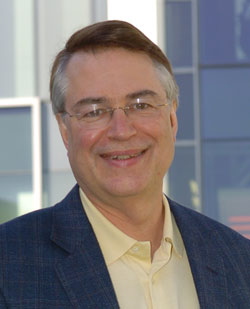By Ken Fountain
Special to the Rice News
Larry Smarr began his scientific career as an astrophysicist studying billions of stars in far-off galaxies. More recently, he’s been studying much larger numbers of units closer to home — his own body.
Smarr, founding director of the California Institute for Telecommunications and Information Technology (Calit2), a joint institute between the University of San Diego and the University of California-Irvine, described his latest venture Nov. 15 in the Ken Kennedy Institute for Information Technology Distinguished Lecture titled “Quantifying Your Superorganism Body Using Big Data Supercomputing.”
Smarr said his “odd journey” over the past five years would give “a view of the future of medicine as it becomes digitally enabled and gets transformed like so many other fields that we’ve seen in our society get transformed.”
Smarr said his background as a physicist, a computational scientist and a student of coral reefs gives him a unique perspective that makes up for his lack of formal training in medicine.
“What one gets trained to do is to be thinking in terms of nonlinear dynamic systems,” he said. “That gives you a very different way of thinking.”
Smarr, 65, described a condition he called “the 40s,” when “your body starts going south on you.” When he arrived at UC-San Diego in La Jolla, he found that his “average American” body didn’t fit in with most of his California colleagues. He said that by studying nutrition and body measuring techniques, he was able to “reverse a lot of the damage.”
For decades there have been “all kinds of ways of monitoring your body,” Smarr said. “The problem is, How do we mash it all up to get the integrated view of the human?”
Gradually, Smarr added new variables to his body’s database — from blood and stool samples, DNA and the like — until they added up to more than 25 million data points.
Ultimately, almost by accident, Smarr discovered on his own that he had a chronic, incurable disease — a late-onset version of Crohn’s disease, an autoimmune disorder.
Referring back to his earlier astrophysics career, Smarr told the audience that a galaxy can contain 100 billion stars. “It turns out that each of you has 1,000 times as many microbial cells in your body as there are stars in Andromeda or the Milky Way galaxy.”
That is, about 100 trillion.
He decided he’d “take this idea of observing, and I’ll turn the telescope around and look at this invisible universe that’s even more complex that’s inside of me.”
Smarr noted there are 10 times as many microbial cells in a person’s body than there are human cells.
The human genome has about 25,000 genes, he said, while the hundreds of species of microbes in the body have more than a million genes.
“Now all of medicine up to this point has only looked at the human cells,” he said. “That’s why figuring out who these other 97 percent of us are will be such a radical transformation. It’s probably going to be a once-in-century level transformation of medicine as we figure out how they interact with us.”
With genome sequencing becoming less expensive all the time, Smarr said, it’s now possible for people to fully understand what a “healthy” humane genome looks like, he noted. By comparing 5 billion “reads” (a read is 100 DNA bases) of healthy genomes with his own six times over a year-and-a-half, he and his doctors were able to derive a taxonomic profile.
It took 25 “CPU years” to do the calculations, and the resulting data was displayed on a 64-megapixel wall at Calit2.
Through the analysis, Smarr and his doctors determined that his body contained numbers of certain microbes that were “severely depleted” from what a “healthy” human body would contain, while others were hundreds of times more prevalent.
“‘You are an ecology’ is a very different mindset from ‘I am a human.’ You’re just 10 percent of the space. The bugs are it,” he joked.
Through further study, Smarr was able to determine that the amount of the E. coli bacteria inside his body made him susceptible to developing colon cancer. But by treating his disease early, he could make changes influencing that trajectory.
Smarr said today it’s feasible to do “system immunology” through supercomputing.
“These are high-performance codes. You should have those people here,” Smarr said, noting the opportunities at the interface between Rice University and the Texas Medical Center, which includes one of the main genome sequencing centers at Baylor College of Medicine.
“We’re going from an analog world of medicine to a digital world of medicine,” he said. “It’s a highly disruptive change brought on by the exponentials of digital technology.”
Ultimately, the use of supercomputing and big data will lead to highly personalized medical treatment and prevention, Smarr concluded.



Leave a Reply